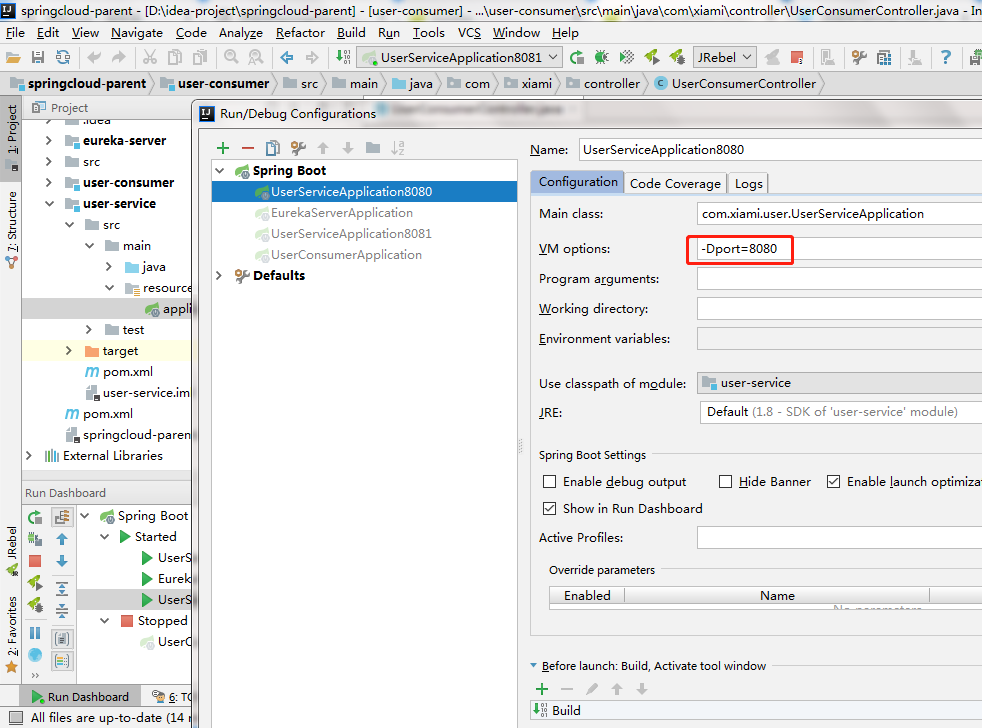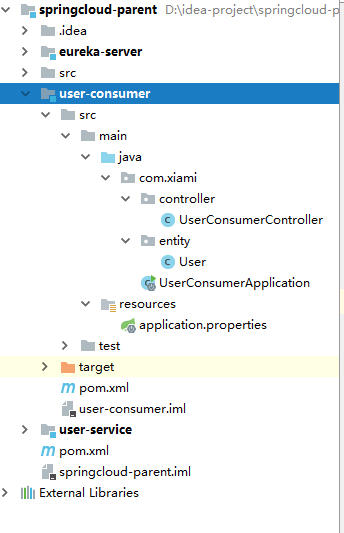前两篇springcloud入门系列文章已经创建好了Eureka注册中心和服务提供者,现在来创建服务消费者。
在创建消费者之前,我们先启动好Eureka注册中心,在微服务架构中,通常会存在多个服务提供者来提供服务,为了方便让服务提供者使用不同的端口号来启动多个服务,我们可以在application.properties文件里把端口号改为读取启动参数的模式。
server.port=${port}

然后再通过配置启动参数来设置端口号(如上图所示),再分别启动8080和8081端口的服务提供者。

启动好后,可以在注册中心看到两个服务提供者了。现在我们开始创建服务消费者,并以url = "http://user-service/user/"+id的形象来模拟负载均衡的方式来调用服务。

这就是服务消费者的目录结构了。
这是pom文件:
<?xml version="1.0" encoding="UTF-8"?> <project xmlns="http://maven.apache.org/POM/4.0.0" xmlns:xsi="http://www.w3.org/2001/XMLSchema-instance" xsi:schemaLocation="http://maven.apache.org/POM/4.0.0 http://maven.apache.org/xsd/maven-4.0.0.xsd"> <parent> <artifactId>springcloud-parent</artifactId> <groupId>com.xiami</groupId> <version>1.0-SNAPSHOT</version> </parent> <modelVersion>4.0.0</modelVersion> <artifactId>user-consumer</artifactId> <dependencies> <dependency> <groupId>org.springframework.boot</groupId> <artifactId>spring-boot-starter-web</artifactId> </dependency> <dependency> <groupId>org.springframework.cloud</groupId> <artifactId>spring-cloud-starter-netflix-eureka-client</artifactId> </dependency> </dependencies> </project>
这是application.properties文件:
server.port=8090
spring.application.name=user-consumer
eureka.client.service-url.defaultZone=http://localhost:8888/eureka
这是服务消费者的启动文件,要注意的是需要在restTemplate方法里加入了@LoadBalanced标签,表示使用Ribbon负载均衡。
。
package com.xiami; import org.springframework.boot.SpringApplication; import org.springframework.boot.autoconfigure.SpringBootApplication; import org.springframework.cloud.client.discovery.EnableDiscoveryClient; import org.springframework.cloud.client.loadbalancer.LoadBalanced; import org.springframework.context.annotation.Bean; import org.springframework.web.client.RestTemplate; @SpringBootApplication @EnableDiscoveryClient public class UserConsumerApplication { public static void main(String[] args) { SpringApplication.run(UserConsumerApplication.class,args); } @Bean @LoadBalanced public RestTemplate restTemplate(){ return new RestTemplate(); } }
我们接着写UserConsumerController文件:
package com.xiami.controller; import com.xiami.entity.User; import org.springframework.beans.factory.annotation.Autowired; import org.springframework.web.bind.annotation.GetMapping; import org.springframework.web.bind.annotation.PathVariable; import org.springframework.web.bind.annotation.RequestMapping; import org.springframework.web.bind.annotation.RestController; import org.springframework.web.client.RestTemplate; @RestController @RequestMapping("/consumer") public class UserConsumerController { @Autowired private RestTemplate restTemplate; @GetMapping("/{id}") public User queryById(@PathVariable Long id){ String url = "http://user-service/user/"+id; return restTemplate.getForObject(url,User.class); } }
User文件:
package com.xiami.entity; public class User { private int id; private String username; private int age; private String ctm; public int getId() { return id; } public void setId(int id) { this.id = id; } public String getUsername() { return username; } public void setUsername(String username) { this.username = username; } public int getAge() { return age; } public void setAge(int age) { this.age = age; } public String getCtm() { return ctm; } public void setCtm(String ctm) { this.ctm = ctm; } }
所有文件都写好后,再启动消费者,最后访问localhost:8090/consumer/3,显示运行成功。

我们也可以在服务提供者的方法里加一下打印日志,然后我们刷新几次上面的URL,就可以看到以间隔的效果来调用服务提供者了。